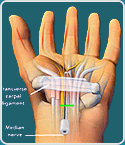 Click to View Carpal Tunnel Endoscopic Surgery Video
Click to View Carpal Tunnel Endoscopic Surgery Video
Carpal tunnel syndrome can present in many different ways, but the symptoms are often described by patients as feeling a “tingling or numbness sensation that sometimes makes their fingers feel asleep”. In addition to this, patients can experience varying amounts of pain in the hand, which is often troublesome at night when they go to bed. Certain remedies such as splinting, resting the hand and inflammatories can provide temporary relief. Carpal tunnel syndrome is a serious condition which implies compression to one of the main nerves innervating the hand. If one does in fact have carpal tunnel syndrome, and ignores the symptoms or simply tries to live with them, this compression can lead to permanent nerve damage, and even following the appropriate surgery this nerve damage may prove to be irreversible and the patient may not regain normal function of the hand. For these reasons, when one is experiencing any of these symptoms it is important to be evaluated sooner rather than later.
Many people ask what caused their carpal tunnel. There is an association between repetitive movements in the hand that can lead to an increased incidence of carpal tunnel syndrome. Often it is during these very activities that the patients reproduce the symptoms they are experiencing. Common activities such as keyboard use, carpentry, or physical work requiring use of the hands has also been described.
Treatment
If you are diagnosed with carpal tunnel syndrome, and indeed are experiencing compression of the nerve to your hand, then the appropriate surgery designed to relieve that pressure should be performed. In the past this was done most often through an “open” approach, which involved a relatively long incision in the palm of the hand which often at times was both tender during recovery and led to a longer recovery period. Dr. Polsen most often performs the carpal tunnel surgery through an endoscopic approach, which not only requires much smaller incision, but allows these incisions to be at a less tender location, contributing to a quicker recovery.



